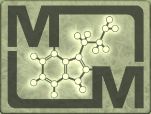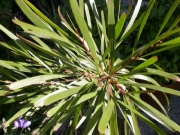 |
MAGISKA MOLEKYLERS WIKI |
Acacia
Generell information
Tillhör familjen Fabaceae.
Acacia kommer ifrån grekiskan akakia som betyder tagg. De är buskar, träd eller växter som växer i tropiska, subtropiska, savanner och halvöknar. Den kontinent som har störst artrikedom är Australien. Det är även där som intresset för Acacia är som störst. På senare år har intresset även ökat i Sydöstra Asien, närmare bestämt Taiwan där man gör en ayahuascaliknande brygd på Peganum harmala och Acacia confusa. I Mellanöstern och Afrika växer det också acacia. Professor Benny Shanon kopplar vissa bibliska händelser till bruket av acacia och p. harmala. [1]
Många acaciaarter innehåller tryptaminer såsom DMT NMT & 5-MeO-DMT samt i viss utsträckning harmelalkaloider och andra betakarboliner. Andra arter (som inte listas här) innehåller fenetylaminer.
Arter
| Namn | Innehåll |
|---|---|
| Acacia acuminata | Tetrahydroharman, DMT, tryptamin, 3-Methyl-Quinoline(osäker), harman, N-Metyl-fenetylamin, fenetylamin. Enligt en uppgift totalt 1.2% alkaloider. [2] |
| Acacia albida | Spår av 5-MeO-DMT, DMT och NMT i löv. |
| Acacia alpina | Aktiva ämnen i löven enligt personer som provat. |
| Acacia baileyana | Ca 0.02% tryptamin och tetrahydroharman |
| Acacia caesia | Tryptamin och DMT-N-oxid i barken [3] |
| Acacia confusa | Ganska hög halt DMT och NMT i barken på stammen och rotbarken. Låg halt i löven. Används som ayahuasca-analog i Taiwan. [2][4][5] [6] |
| Acacia longifolia | Upp till 0.2% DMT, tveksamma källor. |
| Acacia maidenii | 0.13-0.71% alkaloider i barken, bestående av NMT och DMT i ration 2:3 [7] |
| Acacia nilotica | 5-MeO-DMT i stam, löv och rötter |
| Acacia obtusifolia | Alkloiderna i små grenar (0.6-0.7%), blad (0.4-0.5%), bark (0.5-0.6%) innehåller DMT i hög koncentration (>80%). Små mängder DMT-N-Oxide, 2-metyl-tetrahydro-b-carbolin[2] |
| Acacia oerfota (= A. nubica) | 0.016% DMT i löven. [8] |
| Acacia phlebophylla | 0.3% DMT i löv. [9] Utrotningshotad. Bör EJ användas. |
| Acacia polyacantha | 0.004% DMT i löven [8] |
| Acacia rigidula | Se artikeln |
| Acacia senegal | 0.003% DMT i löven [8] |
| Acacia simplex | 3.6% alkaloider från löv, stambark (40% NMT, 22.5% DMT, 12.7% 2-metyl-tetrahydro-b-carbolin[10] |
| Acacia victoriae | DMT i har påvisats i en 1 år gammal planta och 5-MeO-DMT från rötter hos en 2 år gammalt skott.[11] |
Om innehållet
| “ | In the Australian acacias only DMT or DMT in combination with N-methyl tryptamine(NMT) has been found, but this is only from two or three tests on two species, further study may find other related alkaloids. Acacia simplex also contains N-formyl-N-methyltryptamine with DMT and NMT and 2-methyl-1,2,3,4,tetrahydro-b-carboline in it’s phyllodes, but is not found in Australia.. NMT is not particularly psychoactive, but under conditions of MAO inhibition may be converted into DMT and other related compounds by enzymes such as INMT when ingested.
With keeping or under certain conditions DMT and other tryptamine alkaloids may react or change, eg DMT may change to 5-hydroxy-DMT (Bufotenine), an alkaloid also found with DMT in some plants, but generally not recognised as being ‚Äėhallucinogenic‚Äô, it does however have a strong and possibly dangerous effect on the heart. I have no information on the effects of N-formyl-N-methyltryptamine. 5-methoxy-DMT occurs quite commonly with DMT in many of the plants from central and south America and elsewhere. Both 5-methoxy-DMT and DMT under certain conditions, possibly including in the body during metabolism, may convert into b-carboline alkaloids such as 1,2,3,4-tetrahydro-b-carboline and it‚Äôs 2-methyl analog, which interestingly is found along with DMT in a. simplex. Acacia complanata has been reported to contain the b-carboline alkaloids N-methyl-tetrahydroharman and tetrahydroharman, and a. baileyana has been reported to contain the alkaloids tryptamine and/ or tetrahydroharman at different times of the year in the foliage. It seems that the metabolic pathways for these two types of alkaloids have some relationship as they are found together in plants from not only the mimosaceae, but also the poaceae (phalaris spp), myristicaceae (virola spp) and other sections of the leguminosae (desmodium spp). The b-carboline alkaloid, 6-methoxy-tetrahydroharman is reported to occur naturally as a hormone in the pineal gland and to be ‚Äėhallucinogenic‚Äô above 1.5 mg/ kg ( this may infact be 5-methoxy-N-acetyltryptamine, or melatonin, a hormone produced at night by the pineal gland, whereas serotonin, 5-hydroxytryptamine, is produced during the day. Melatonin has recieved much attention recently as a nootropic type drug, and to treat insomnia. It is obviously very closely related to the entheogenic tryptamines.). |
‚ÄĚ |
Externa länkar
- ‚ÜĎ Biblical Entheogens: a Speculative Hypothesis
- ‚ÜĎ 2,0 2,1 2,2 DMT Nexus - The Acacia Analysis Thread
- ‚ÜĎ Ghosal, S. 1972. "Occurrence of psychodelic substances in some Indian medicinal plants." Planta Medica 21:200-209.
- ‚ÜĎ Asian Ayahuasca - Formosahuasca
- ‚ÜĎ New Psychedelic Root Discovered
- ‚ÜĎ Acacia confusa & Formosahuasca
- ‚ÜĎ Fitzgerald, J.S. & Sioumis, A.A. 1965. ‚ÄúAlkaloids of the Australian Leguminosae. V. The occurrence of methylated tryptamines in Acacia maidenii F. Muell.‚ÄĚ Aust. J. Chem. 18:433-434.
- ‚ÜĎ 8,0 8,1 8,2 Khalil, S.K.W. & Elkheir, Y.M. 1975. ‚ÄúDimethyltryptamine from the leaves of certain Acacia species of Northern Sudan.‚ÄĚ Lloydia 38(3):176-177.
- ‚ÜĎ Rovelli, B. & Vaughan, G.N. 1967. ‚ÄúAlkaloids of Acacia I. NbNb-Dimethyltryptamine in Acacia phlebophylla F. Muell.‚ÄĚ Aust. J. Chem. 20:1299-1300.
- ‚ÜĎ Poupat, C. et al. 1976. ‚ÄúAlcalo√Įdes de Acacia simplicifolia.‚ÄĚ Phytochemistry 15:2019-2020.
- ‚ÜĎ Trout, K. & Friends. 2007. Some Simple Tryptamines. Second edition. Mydriatic Productions, USA.
- ‚ÜĎ Shaman Australis
- ‚ÜĎ List of Acacia species known to contain psychoactive alkaloids Wikipedia (en)
- ‚ÜĎ Acacia and Entheogenic tryptamines
Australian and extra Australian Acacia Mycket information!
Institutionen för Läkemedelskemi, Avdelningen för Farmakognosi
Sidan ändrades senast 29 december 2013 klockan 12.13.
Den här sidan har visats 18 424 gånger.












